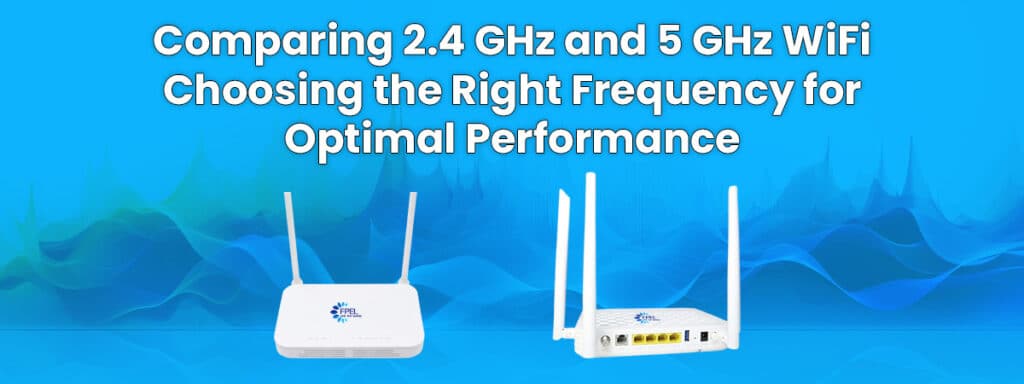Introduction:
In today’s interconnected world, WiFi has become an indispensable part of our daily lives. With the ever-increasing demand for faster and more reliable wireless connections, it’s crucial to understand the differences between the available frequency bands. This article delves into the comparison between the 2.4 GHz and 5 GHz WiFi bands, highlighting their strengths, weaknesses, and helping you make an informed decision when setting up your optical network unit (ONU) WiFi network.
The Basics: Frequency Bands and Their Characteristics
Before delving into the comparison, let’s understand the fundamentals of the 2.4 GHz and 5 GHz frequency bands.
1.1 2.4 GHz WiFi:
The 2.4 GHz frequency band has been the standard for WiFi networks for a long time. It offers a larger coverage range and better penetration through walls and obstacles. However, due to its popularity, it is often crowded with numerous devices such as microwaves, cordless phones, and other WiFi networks, leading to potential interference and reduced performance.
1.2 5 GHz WiFi:
The 5 GHz frequency band is relatively newer and less congested compared to the 2.4 GHz band. It provides faster data transfer speeds and is ideal for high-bandwidth activities like online gaming, video streaming, and file transfers. However, the 5 GHz signal has a shorter range and may experience more significant attenuation when passing through physical barriers.
Performance Factors: Speed, Range, and Interference
To make an informed decision about which WiFi frequency band to use, consider the following performance factors:
2.1 Speed:
In terms of raw speed, the 5 GHz band outperforms the 2.4 GHz band. With a wider channel bandwidth and less interference, it can deliver higher data transfer rates, resulting in smoother and faster internet browsing, downloads, and streaming experiences.
2.2 Range:
While the 2.4 GHz band has a longer range due to its lower frequency and better penetration capabilities, the 5 GHz band is more limited in range. However, advancements in WiFi technology have reduced this gap, and modern devices can still provide adequate coverage within a typical home or office environment.
2.3 Interference:
Interference is a crucial factor that can impact WiFi performance. The 2.4 GHz band is more prone to interference from other electronic devices, neighboring WiFi networks, and even physical barriers. On the other hand, the 5 GHz band encounters less interference, making it a preferred choice for crowded areas or locations with multiple WiFi networks.
Device Compatibility:
Compatibility with your existing devices is another critical aspect to consider:
3.1 2.4 GHz Compatibility:
The majority of WiFi-enabled devices, including smartphones, tablets, laptops, and smart home devices, are compatible with the 2.4 GHz band. It offers broad compatibility across a wide range of devices and ensures seamless connectivity.
3.2 5 GHz Compatibility:
While most modern devices now support the 5 GHz band, it’s important to note that some older devices may only support 2.4 GHz. Therefore, if you have older devices or IoT devices that rely solely on the 2.4 GHz band, using a dual-band router that supports both frequencies would be ideal.
Choosing the Right Frequency for Your ONU WiFi Network:
To determine the optimal WiFi frequency for your ONU network, consider the following:
4.1 Internet Usage:
Assess your internet usage patterns and the activities you frequently engage in. If you primarily use your network for web browsing, email, and light streaming, the 2.4 GHz band may suffice. However, if you engage in high-bandwidth activities such as online gaming, 4K streaming, or large file transfers, the 5 GHz band will provide a better experience.
4.2 Network Environment:
Evaluate your network environment and nearby WiFi networks. If you live in a densely populated area or an apartment building with many neighboring networks, the 5 GHz band may offer less interference and improved performance. However, in larger spaces or areas with more physical barriers, the 2.4 GHz band’s better range may be beneficial.
4.3 Dual-Band Routers:
Consider investing in a dual-band router that supports both 2.4 GHz and 5 GHz frequencies. This allows you to create separate WiFi networks for different devices and optimize performance based on individual device capabilities and requirements.
Conclusion:
In the 2.4 GHz vs. 5 GHz WiFi debate, there is no one-size-fits-all answer. The choice depends on your specific needs, network environment, and device compatibility. Understanding the differences in speed, range, and interference characteristics of these frequency bands will empower you to make an informed decision for your ONU WiFi network. Remember to consider future scalability and invest in modern, dual-band routers for maximum flexibility and performance

